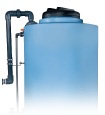When considering storage solutions for chemicals used in the wastewater process, two options available are fiberglass reinforced plastic (FRP) and polyethylene (“poly”).
Topics:
Applications
While most of the storage tanks that we sell are vertical tanks, vertical tanks with IMFO, sloped bottom tanks with IMFO, and double wall SAFE-Tanks, we do offer several other options to customers. Vertical tanks simply are not the best solution for every circumstance. Let’s look into the three main reasons polyethylene horizontal tanks are a key part of a storage solution and then expand on the use of these tanks in their most popular industry: agriculture.
Topics:
Applications,
Tank Design and Materials
Whenever an earthquake happens, the clean up leaves clues about safe storage of liquid materials. In 2014, a Napa Valley earthquake left winery operations with thousands of broken wine bottles and damaged and crushed storage tanks to clean up. Let’s take a look at what happened, best practices for wine storage, and how you can protect your wine stock from potential damage.
Topics:
Applications,
News and Customer Stories
Our goal is to continually update you of any and all internal changes that may affect your poly storage tank system. With that goal in mind, we have a few clarifications and updates on how we now meet NSF certification with polyethylene tank materials.
Topics:
Value Added
If you have recently purchased a tank for chemical storage or you are thinking about it, there are a few things you might want to consider before and after the purchase of one. Not only is this to protect the tank itself, but also the solution you are placing in the tank and your workers' and employees' safety.
Topics:
Value Added
With all of the uses for polyethylene, there are many companies and plants that need rotationally molded products not currently offered by manufacturers. Thankfully, working with a specialist to build a custom built solution is a viable option in order to manufacture a unique product that meets your exact specifications.
Topics:
Value Added
Recently, a chemical storage spill occurred at a Roanoke metals processing plant. A forklift punctured a storage tank containing hydrochloric acid. This pungent liquid is a strong, highly corrosive acid that creates toxic and potentially fatal fumes. Because of the high-risk chemical involved, the plant was quickly evacuated. Thankfully, the spill was less than 100 gallons and could be contained with minimal impact on the plant production schedule, and most importantly, no one was injured.
Topics:
News and Customer Stories
The popularity of craft brewing is exploding across the United States. To date, over 3000 craft breweries exist. Smart, flexible, cost-effective storage of the dry ingredients, water, and cleaning agents and chemicals used in the brewing process is essential.
Topics:
Applications
In locations where chemical storage tanks are subject to earthquakes and heavy winds, tank restraint systems are critical. A proper tank restraint system prevents the tank from sliding or tipping over. Tank restraints prevent against damage to the tank itself, and a potential costly environmental cleanup from a spill.
Topics:
Fittings and Accessories
Safe storage of chemicals is vital. In a previous article, we recommended a comprehensive annual chemical storage tank inspection to detect cracking and crazing, gasket and fitting issues,and several other points on and around the tank that could develop into potential problems.
Topics:
Value Added



